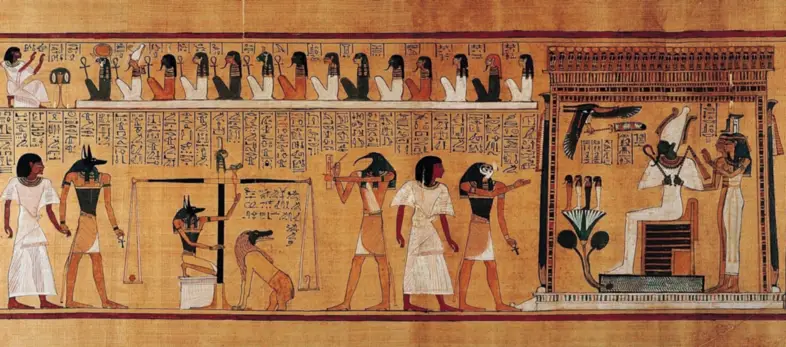 ancient Egypt, death was not the end, but a mere passage to another realm. Hence the need to provide the deceased with all the necessities for the trip. In Greece and Rome, on the contrary, death leads directly to the world of shadows, not necessarily a nightmare, but in any case the end of life. This is also seen in many other cultures as well as depicted in various ways by different religions, however, Ancient Egyptian mythology shows a different perspective.
ancient Egypt, death was not the end, but a mere passage to another realm. Hence the need to provide the deceased with all the necessities for the trip. In Greece and Rome, on the contrary, death leads directly to the world of shadows, not necessarily a nightmare, but in any case the end of life. This is also seen in many other cultures as well as depicted in various ways by different religions, however, Ancient Egyptian mythology shows a different perspective.
Osiris: The lord of beyond
Osiris is addressed as the gatekeeper to the Egyptian paradise. Only with his blessing could the souls of the deceased enter. The Egyptians had a keen awareness of death and as a result a permanent preoccupation with the afterlife. This does not mean that they didn’t fear death, on the contrary, they consider it to be a source of pain and fear that would push people towards living a good life until the final day would come.
Even if the Egyptians believe that only gods have power over life and death, there is no special deity that symbolizes death. It is generally addressed to an unjust person. But beyond fear, they still have the certainty of later life.

For Egyptians, it was normal to spend their entire life on earth preparing for the afterlife. This was also taking into account their behavior within their present life as depicted in the first picture, the Gods would balance the good deeds as well as the bad doings in life to see what sort of fate they deserve after their death. This is also why funeral offerings were a normal thing and still remain something normal in today’s day in various religions as it is believed that you cannot live without food in the afterlife.

At the end of the Old Kingdom of Egypt, funeral beliefs were democratized, and the social elites took over prerogatives that removed the royal monopoly on survival. This revision of concepts led to a religion centered on Osiris’s personality. The key to later life was no longer the proximity of the pharaonic tomb, but the sharing of Osiris’ destiny. Osiris, the eldest of the children of Geb and Nut, inherits the earthly kingdom.
His brother Seth, out of jealousy, kills him and chops him into pieces that he had scattered throughout Egypt. Helped by his sister Nephtys and his wife Isis, recover them by creating the first mummy. Thot returned his life and Osiris became the ruler of the world beyond, the only one who bears the hope of eternal life. Like Osiris, the deceased must undergo the rite of mummification, the first step in his identification with the god.
Material and Spiritual Elements
At the moment of death, which is nothing more than a passage, the elements disperse but retain their integrity. If their reassembly, which involves body conservation, succeeds, life with Osiris becomes possible. Once the body is reconstituted, the deceased must succeed in integrating into the sphere of the gods, becoming Osiris himself.
In practice, those of non-royal descent had no hope of reaching this goal of becoming one with Osiris. Access to the divine circle is conditioned by an exemplary life, which respects and practices the Ma’at principles, a notion that embodies order and truth. So individual achievements ensure eternity.
These are seen in the so-called judgment of the dead, in which the actions of the dead are carefully analyzed by Anubis, psychopomp deity, and Thot the patron of intellectual activity. After this Osiris gives the definitive verdict.
The scene takes place in front of the great God and the 24 assistants. In the center of the room is a balance on whose plates placed the heart and the feather, the symbol of his or her Ma’at. If his soul is heavier, the deceased reach the infernal monster and is condemned to roam in Noun, the original chaos of hell from Egyptian mythology.

Otherwise, this can take place in the Osiris suite. The weighing of the soul is accompanied by another operation, the negative confession, in which the deceased proclaims his innocence by declaring all the wrongs that he did not commit. At the end of the journey, he receives a piece of land that he works to secure for the glory of God.
Indispensable for securing the afterlife is also the pilgrimage to Abydos, the holy city of Osiris, where Nephtys and Isis found the head of God and the burial of a memorial star. At the end of the flood season, a holiday reiterates the mysteries of Osiris, centered on the idea of regeneration and cyclicality of existence.
Today, all religions, cultures, and cults come to an average conclusion that some sort of afterlife awaits us all. There is still very little known about the souls which control our bodies and their true existence. Death may seem very simple based on the fear that is implied by a certain end of everything for whoever dies, but from a philosophical perspective, death is very difficult to comprehend.
Avid Writer with invaluable knowledge of Humanity!
Upcoming historian with over 30 million views online.
“You make your own life.”





